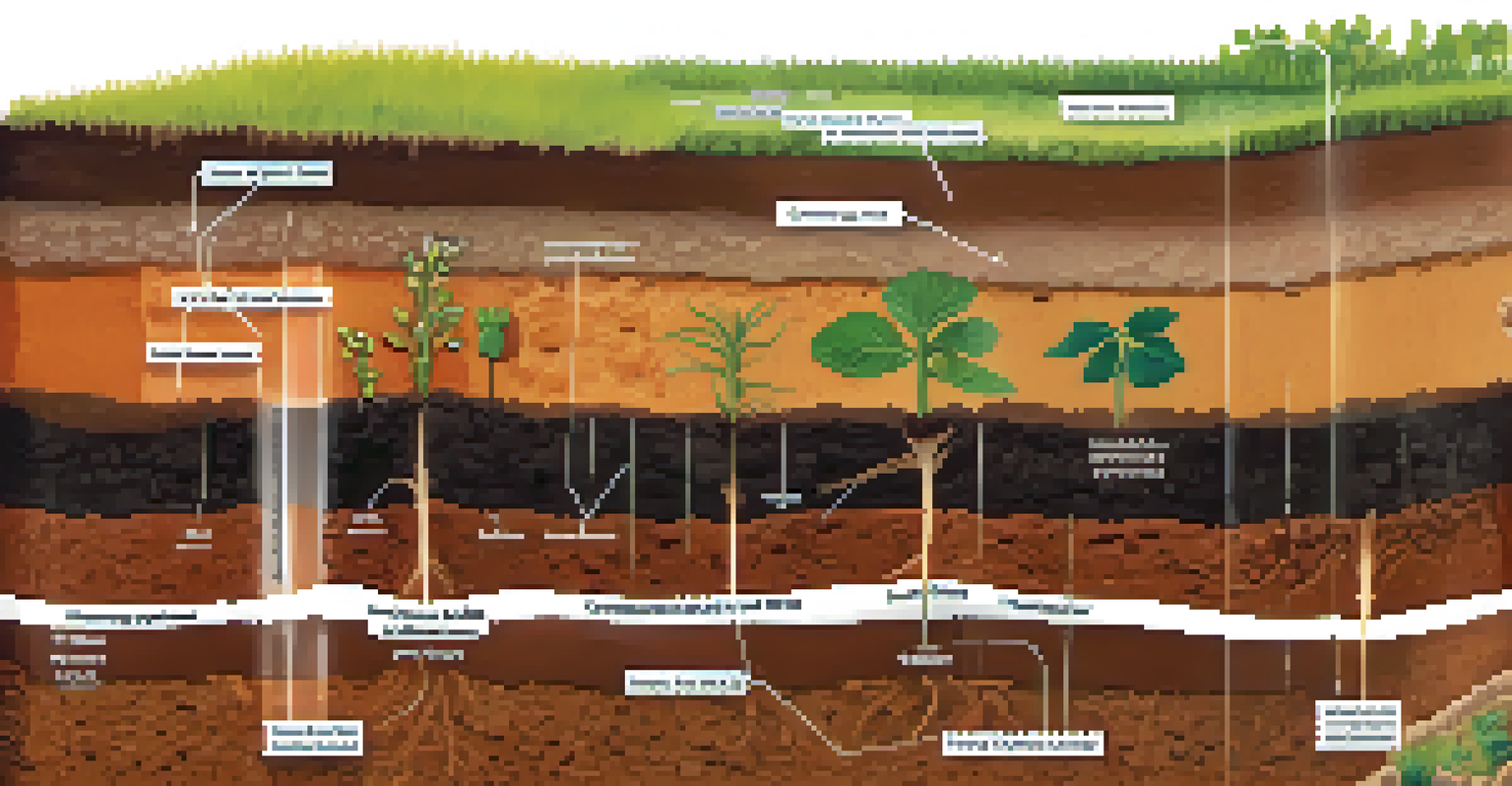Plant Sensitivity: How Roots Sense and Respond to Soil

The Basics of Plant Root Sensitivity
Plant roots are far more than just anchors; they are sensitive sensors that interact with their environment. Root sensitivity allows plants to detect changes in soil conditions such as moisture, nutrients, and even the presence of harmful substances. Understanding this sensitivity is crucial for appreciating how plants thrive in diverse environments.
Plants are not just passive beings; they are active participants in their environment, constantly sensing and responding to their surroundings.
Roots communicate with the soil through a complex network of signals. They can sense physical properties like soil texture and chemical signals that indicate nutrient availability. This ability to perceive and respond to their surroundings is essential for their growth and survival.
For example, when roots encounter dry soil, they can slow their growth to conserve energy. This adaptive strategy illustrates how plants prioritize their survival by responding intelligently to their immediate environment.
How Roots Sense Soil Moisture Levels
One of the primary ways roots sense their environment is through moisture levels in the soil. Roots have specialized cells that can detect changes in water availability, which is vital for a plant's overall health. When moisture is scarce, these cells send signals that prompt the plant to initiate drought-resistant behaviors.

This sensory mechanism is akin to how humans feel thirst; roots 'know' when they need more water. In response, the plant may grow deeper roots to access underground water or close its stomata to reduce water loss. Such actions help the plant manage its resources efficiently.
Roots Detect Soil Conditions
Plant roots are sensitive to changes in soil moisture, nutrients, and pH, allowing them to adapt for survival.
For instance, during a drought, plants with deeper root systems can tap into moisture that surface roots cannot reach, giving them an advantage over those with shallower roots.
Nutrient Sensing and Uptake by Roots
Another critical aspect of root sensitivity is nutrient sensing. Roots are equipped to detect essential nutrients like nitrogen, phosphorus, and potassium in the soil. When nutrient levels drop, roots can increase their growth rate in search of richer soil, ensuring the plant receives what it needs to thrive.
Roots are the hidden half of a plant, yet they are pivotal in its overall health and adaptability.
This nutrient-hunting ability is a remarkable adaptation, much like how animals forage for food. Roots release specific enzymes to break down organic matter, making nutrients more accessible. This process not only benefits the plant but also plays a role in the soil ecosystem.
For example, legumes have symbiotic relationships with nitrogen-fixing bacteria in their roots, enhancing their nutrient uptake while enriching the soil for surrounding plants. This mutual benefit illustrates the complex relationships within ecosystems.
Roots and Soil pH Sensitivity
Roots are also sensitive to soil pH, which affects nutrient availability and overall plant health. Different plants thrive in different pH ranges, and roots can sense these variations to optimize their growth. When the soil becomes too acidic or alkaline, roots may adjust their growth patterns accordingly.
This sensitivity can be compared to a person adjusting their diet based on nutritional needs. For instance, when roots detect a low pH, they may increase the production of certain proteins that help them absorb nutrients more effectively. This adaptability is crucial for maintaining health.
Chemical Signals Aid Communication
Roots use chemical exudates to interact with soil microorganisms, enhancing nutrient uptake and defending against pathogens.
An example can be seen in blueberries, which prefer acidic soils. Their roots are adapted to thrive in these conditions, showcasing how specific plants have evolved to fit their preferred environments.
The Role of Chemical Signals in Root Behavior
Chemical signals play a significant role in how roots sense and respond to their environment. Roots can release exudates—substances that alter the chemical composition of the soil—thereby attracting beneficial microorganisms and repelling harmful ones. This interaction is vital for maintaining a healthy root zone.
Think of exudates as a plant's way of negotiating with its surroundings. By sending out specific chemicals, roots can 'talk' to the soil, inviting helpful bacteria that enhance nutrient absorption or fend off pathogens. This behavior highlights the interconnectedness of plants and their environments.
For example, certain plants release compounds that encourage mycorrhizal fungi to colonize their roots, forming a symbiotic relationship that improves nutrient uptake. This cooperation illustrates the sophisticated communication plants engage in with their soil ecosystem.
The Impact of Soil Compaction on Root Sensitivity
Soil compaction is another factor that affects root sensitivity and overall plant health. Compacted soil limits root growth, making it harder for plants to access water and nutrients. Roots can sense this physical barrier and may alter their growth patterns to navigate around it.
This situation can be likened to trying to move through a crowded room; if the path is blocked, you have to find another way. Roots may increase lateral growth or develop specialized structures to penetrate compacted layers, showcasing their adaptability.
Compaction Affects Root Growth
Soil compaction limits root access to resources, prompting roots to change their growth patterns to navigate obstacles.
For instance, some plants can develop thicker, stronger roots that can break through hard soil layers, allowing them to thrive even in challenging conditions. This resilience is a testament to the incredible adaptability of plant systems.
Future Research on Plant Root Sensitivity
As our understanding of plant sensitivity evolves, researchers are exploring innovative ways to harness this knowledge. Studying how roots respond to various soil conditions could lead to agricultural practices that enhance crop resilience and productivity. This research is particularly critical in the face of climate change and soil degradation.
Future studies may offer insights into developing plants that can thrive in less-than-ideal soil conditions, potentially reducing the need for chemical fertilizers and pesticides. This approach could lead to more sustainable farming practices, benefiting both farmers and the environment.

Ultimately, delving deeper into root sensitivity will not only improve our agricultural systems but also contribute to preserving biodiversity and ecosystem health. The more we learn about these underground networks, the better we can support our planet's green life.